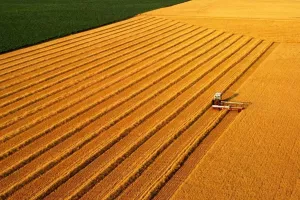Desert, in people's mind, seems to be synonymous with "monotony" and "loneliness". However, the scenery of the desert is sometimes breathtaking, and it will also fascinate people who have lived in the urban made of reinforced concrete for a long time.
1. Taklamakan Desert
Located in the center of Tarim Basin in southern, Taklamakan desert is the largest desert in China, the tenth largest desert in the world, and the second largest mobile desert in the world. The whole desert is about 1000 kilometers long from east to west, covering an area of 330000 square kilometers. The average annual precipitation is no more than 100 mm, and the lowest is only 45 mm; The average evaporation is as high as 2500~3400 mm. Here, the pyramid shaped sand dunes stand at -300 meters away from the thousand plains. The strong wind can blow up the sand wall, which can reach three times its height. The sand in the sand pool is continuous, and the sand often moves under the influence of the wind. There are also a small number of plants in the desert. Their root systems are extremely developed, tens or even hundreds of times more than the aboveground parts, to absorb underground water. Animals there have the phenomenon of summer sleep.
2. Uyuni desert
Uyuni desert is a representative scenic spot in Bolivia. It is in the plateau area in the southwest of Bolivia. It is 250 kilometers long from east to west, 150 kilometers wide from north to south, and covers a total area of 12000 square kilometers. It is the largest Salt Lake in the world. Uyuni is worthy of the title of the world's largest Salt Lake. It is said that the salt layer here is more than 10 meters thick in many places, with a total reserve of about 65 billion tons, enough for people all over the world to eat for thousands of years. The local people are close to the water, so they don't have to spend money to eat salt. However, the conditions for playing here are quite difficult: the lake area, with an altitude of 3700 meters and an area of more than 10000 square kilometers, is uninhabited. There is no reference for identifying the direction.
3. Farafra desert
Farafra desert is located 45 kilometers north of Farafra, Egypt. It is a famous white desert on the earth. The name of the white desert comes from dry, white, and evil. These chalks stand tall in the desert and are eroded into different shapes by dust storms, such as mushrooms, minarets, and peaks. The strangest thing about Egypt's Farafra desert is that it is a white desert. The desert is as white as cream, in sharp contrast to the yellow deserts in other parts of the world. Farafra desert in Egypt is a famous white desert on the earth. The name of white desert comes from chalk, which stands tall in the desert and is eroded into different shapes by sandstorms, such as mushrooms, spires, peaks, etc.
4. the Sahara
The Sahara Desert formed about 2.5 million years ago, covering an area of about 9.06 million square kilometers. It is the largest sandy desert in the world. It is in northern Africa, where the climate conditions are very bad, and it is one of the most unsuitable places on earth for biological survival. "Sahara" is a transliteration of Arabic. In Arabic, "Sahara" is a great desert, which originates from the language of the Tuareg people, a local nomad. Its climate is similar to dry East Africa. About 30000 ancient rock paintings have been found in the desert, about half of which are in the Tassili n'Ajjer plateau in southern Algeria, depicting animals in rivers, Such as crocodiles.
5. Lencois Maranhenses
Lencois Maranhenses is in Estado de Maranho of Brazil, which is also the northern coastal area of Brazil. In 1981, the Brazilian government established a national park here, covering an area of about 1500 square kilometers. Lencois Maranhenses is composed of many white sand dunes and dark blue salt water lakes. Its beautiful scenery is unique in the world. The sand dunes extend inwards for 50 kilometers from the coast, forming a landscape like white sheets. This is why it was named "Lencois", which means bed sheet in Portuguese.


